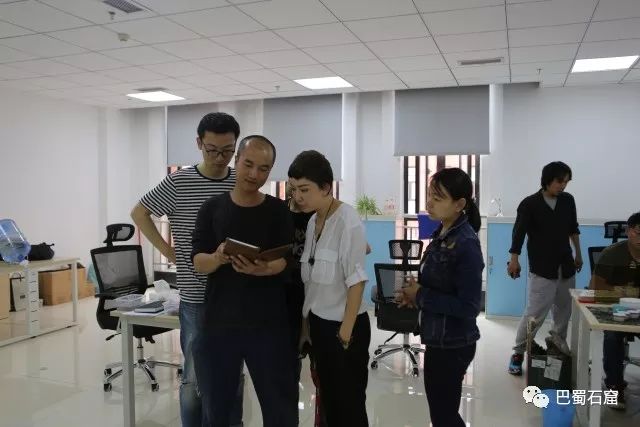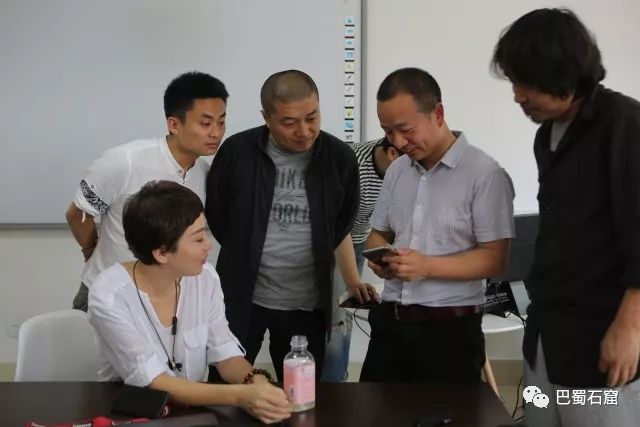《实践的挑战:佛教与当代艺术》 The challenge of Practice--- buddhisum and contamprory art
- NOTHINGART

- Apr 25, 2018
- 5 min read
Updated: Oct 24, 2022

实践的挑战:佛教与当代艺术
Practical Challenges: Buddhism and Contemporary Art

讲座进行中
复旦大学人类学博士李捷,每天在世界各地飞来飞去做艺术做研究,李耘燕老师形容她是一个天马行空的人,她的思维在天马行空中带着严密的逻辑性,她给我们带来的讲座《实践的挑战:佛教与当代艺术》,内容充实而精彩纷呈,思路清晰又富有跳跃性,就充分证明了这点。李捷老师表示《巴蜀石窟造像绘画创新人才培养》项目组25位学员都是对佛教理念、对佛教石窟有感情的艺术家,一起交流、分享、学习,一定也能从各位艺术家的身上学到东西。
Dr. Jie Li-Elbrächter specialized in anthropology at Fudan University, always fly around the world to conduct art research every day. Lecturer Li Yunyan described her as a sky-walking person, and her thinking is carried with strict logic in the sky, she brought us the lecture "Practical Challenges: Buddhism and Contemporary Art", which was fulfilled and brilliant, with clear ideas and some leaps in between. Dr. Jie Li-Elbrächter said that the 25 students in the project team of “Innovative Talents Training in Bashu Grottoes Paintings” were all artists who have an idea of Buddhism and feelings about Buddhism grottoes. Through communicating, sharing, and learning together, you will certainly be able to learn from them also.

讲座进行中
李老师从杜尚的车轮开始讲起,车轮与达摩轮的关系,阿布拉莫维奇的行为作品与冥想的关系。从铃木大拙讲到约翰凯奇,从劳申伯格讲到卡普罗,并展示了很多与佛教相关的,从佛学得到启发的当代艺术家的作品。对于艺术概念名词,李老师也通过多年在欧洲和亚洲各个国家学习和研究做了具体的不同国家的概念明确,避免使用拿来主义,对同时间段的中国和欧洲的艺术历程进行了详细的讲解,并不断的对同学们提出问题,启发大家对佛教和艺术的联系的深入思考。就像杜尚对自己每一件作品从文字到形式的深入反复思考一样。李老师认真仔细的分析了杜尚的很多件与观音有关的作品,启发大家如何一步步沉入自己的作品中,深入自己的内心,去“看”最原始最纯朴的“声音”。
用真诚的态度面对自己的作品和艺术生涯,无论最后的呈现模式是写实、抽象、装置或行为,其实本源都是一样的。我们尊重的都是佛的普世、慈悲、无我的境界。艺术家与修佛之人一样,都在修行的路上。同时也希望各位艺术工作者能够通过自己的作品将石窟艺术更大范围的推广,让更多的人知道,更多的人有学习传统、保护传统的意识。
Dr. Jie Li-Elbrächter started with Du Shang's wheel, the relationship between the wheel and the Dharma wheel, the relationship between Abramovich's performance works and meditation. She talked about John Cage from Suzuki, and Capro from Rauschenberg, and showed many works of contemporary artists inspired by Buddhism. Regarding art concept terms, Dr. Jie Li-Elbrächter has also specified different countries clearly through years of study and research in various countries in Europe and Asia. She talked through the details of the art history of China and Europe. She also explained and constantly asked questions to students, inspiring everyone to think deeper about the connection between Buddhism and art. It was just like Du Shang's in-depth reflection on each of his works from words to the form. Dr. Jie Li-Elbrächter had analyzed many of Du Shang's works related to Guanyin, inspiring everyone how to sink into their own works step by step, deepen their hearts, and "see" the most original image and listen to the simplest "voice".
Facing your own artworks and artistic career with a sincere attitude, whether the final mode is realistic, abstract, installation, or behavior, in fact, the origin is the same. We respect the universal, compassionate, and selfless state of the Buddha. Artists, like those who practice Buddha, are on the way to practice. At the same time, Dr. Jie Li-Elbrächter also hopes that all artists can promote the art of grotto through a wider range of their works so that more people know that more people have the consciousness of learning and protecting traditions.
李捷老师与学员们交流
艺术家和修佛者,引用爱普斯坦的话:“要找到他们自己的道路进入这个状态——佛启示了这条路;也告诉了我们当你到达那里时该做些什么。”李老师在讲座中提到在现在的社会上,关注石窟并且带有感情的人还是少数。当现代艺术形式碰上带着中国传统的儒释道思想的巴蜀石窟造像,会产生怎样的火花呢?我们不得而知。但是在传统的基础上,结合当代艺术进行相对应的思考,能够激发更广泛的创作灵感。
当我们在石窟现场面对着佛像安静而虔诚的写生时,是否能够感受到石窟造像中所传达出来的当时的工匠对佛教的那种信仰,对佛教精神的尊重和信任?能否在之后的创作中,将自己的真情实感融入其中,创作出具有精神内涵的作品?这都是我们需要思考的问题。
Artists and Buddhist practitioners quoted Epstein: "To find their own way to enter this state-the Buddha has inspired this way; also told us what to do when you get there." Dr. Jie Li-Elbrächter was in the lecture It is mentioned in the current society that there are still a small number of people who pay attention to grottoes and have feelings. When the modern art form meets the statue of Bashu Grottoes with Chinese traditional Confucianism, Buddhism, and Taoism, what kind of spark will it produce? We don't know. But on the basis of tradition, combined with contemporary art, corresponding thinking can inspire a wider range of creative inspiration.

李捷老师接受项目聘书
从佛学理念中提取出来,融入到艺术创作中去,在这过程中,每一位艺术家对待艺术都应该虔诚、投入。我们将像阿布拉莫维奇在西藏学习了冥想和佛教后,佛法内在的精神和哲学理念对她内心的改变和对其艺术生涯的影响一样,接受传统文化的熏陶洗礼,真挚而诚恳地用艺术的方式绘出古人的虔诚和佛性的怜悯。
It is extracted from the concept of Buddhism and then integrated into artistic creation. In this process, every artist should treat the art with piety and devotion. Like Abramovic ’s study of meditation and Buddhism in Tibet, the inner spiritual and philosophical ideas of the Dharma changed her mind and influenced her artistic career. The artistic way paints the piety of ancient people and the mercy of Buddha-nature.







Comments